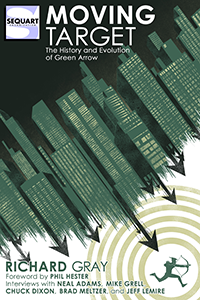“Beware the best-of list”, Shakespeare once wrote. Or he should have. There are deep problems with basing one’s opinion of the literature worth reading on one critic’s list of the “best” of the year, most obviously that any critic making such a list presumes that they have read all the potential candidates in any given year. That certainly isn’t true with me. I have obvious prejudices and tastes, and haven’t read everything that was offered to us, the reading public, this past year. In fact, I probably have read only an embarrassingly small slice of the wide spectrum of comics published recently. So, while we would love to bring you the “Sequart’s best comics of 2015” list, a more honest title would be “My favourite comics of 2015”.
With that caveat, I can’t help but go back to my pick from last year, Manifest Destiny. Written by Chris Dingess and illustrated by Matthew Roberts and Owen Gieni, this fantasy metaphor wedding the Lewis and Clark expedition with Swamp Thing and deep American myths is still a superb book. In fact, its most recent issue (#18) is probably among its very best, touching on devastating notes of genocide and evil in the pursuit of manifest destiny itself. But the book also wandered into the fantasy genre quite a bit, which seemed to turn off some readers (present company not included). While I would love to give the nod again to Manifest Destiny, the book that was consistently intelligent, captivating and fascinating to me this year was another Image Comics title, Invisible Republic.
Invisible Republic is a science fiction epic about how history is made, told and re-made. Although set on another planet, and supposedly farther into the future than the 21st century, the story’s human contours are very familiar and universal. Arthur McBride, an angry, bitter, determined freedom fighter, emerges from the mists of Avalon (literally), and becomes wrapped up in a larger struggle to topple the government and seize power. Arthur flies the usual revolutionary colours: he’s doing it all for the freedom of “his people”, for “justice”, etc., but the more we get to know McBride, the more it seems like he’s in it simply to cause trouble and is working on some sort of personal vendetta. We see Arthur’s rise through the eyes of Maia Reveron, his cousin, who fled their collective farm with him and becomes immersed in the revolution, even though she maintains a certain emotional and moral distance from the situation. It’s Maia who wonders, aloud, whether what they’re doing is for the overall good, and especially wonders how free the individual members of McBride’s growing rebel organization are to disagree – or leave.
The story of McBride’s rise is counterpointed with a parallel story-line, set “42 years later”, in which journalists are working to uncover the untold story of the “Malory Regime”, as McBride’s movement came to be called, which ruled for years before it finally fell. The key historical source is a journal kept by Maia Reveron in her youth, which gives an unusually personal and indeed intimate perspective on monumental societal shifts. With each passing issue (there have been eight so far), we learn more about Maia, more about the past and gradually, we learn a little bit about the present. Interestingly, the present is the least clear timeline, which makes a certain amount of sense. The past is always clearer than the present, and we follow our two journalist heroes, Babb and Woronov, as they sink deeper and deeper into the story of Maia, Arthur and the Malory Regime.
This is an unusually intelligent and adult-oriented comic, the epitome of “hard” science fiction, and while there are action scenes, these are kept to a minimum. Co-writers Gabriel Hardman and Corinna Bechko keep the tension high, and base the conflicts on true moral struggles and character flaws, rather than obvious protagonist-antagonist fights. Hardman’s artwork, embellished wonderfully by colourist Jordan Boyd, is both epic and intimate, with evocative faces and Blade Runner-inspired cityscapes. An early scene set at the seacoast is as effective as any later scene set in the dense urban revolutionary jungle. Boyd’s colours are used to excellent storytelling effect, creating two distinctive palettes for the past and the present.
Through its eight issues, Invisible Republic continues to be surprising in terms of narrative, evocative in terms of visuals and uses the comics medium to its best effect. It’s unquestionably a book that deserves to be read, and is my choice for the best of 2015.
Of course, there were many other great comics in 2015, and I, in particular, also enjoyed two of Jeff Lemire’s books, Plutona, which highlights his skills with writing child characters, and Descender, a great science fiction epic that continues to surprise. Other notable books were Jason Aaron and rm Guera’s The Goddamned, which recounts the Old Testament with its original speed and violence, and Negative Space, a fantastic book about depression and social isolation by Owen Gieni and Ryan K. Lindsay. Possibly the most creative new book of the year was 8House, an anthology science fiction series that cheerfully waltzes past outdated genre limitations and restrictions, presenting stories that embrace gender fluidity, diversity and a refreshing female-centric take on sci-fi/fantasy. And finally, Southern Bastards by Jason Aaron and Jason Latour remains probably the best example of dark melodrama in the entire comics medium. None of these books should be missed.
But for 2015, it’s Invisible Republic, a comic so good, so imaginative and intelligent, that it reflects the ways in which our approach to science fiction, and comics in general, is evolving and expanding to embrace diverse voices and creative takes on familiar genres. Let’s hope the trend continues into the second half of this decade.





















































